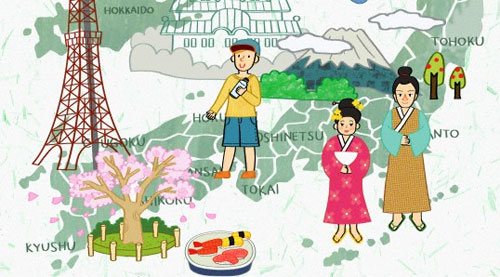Amazing Facts » Facts And Trivia About Countries – Japan

Amazing Facts about Japan
Here are some interesting facts for kids on Japan. Check out these awesome facts and information, which will help explain more about people and travel. The information presented is interesting and serve kids and adults on an overseas trip to Japan.
Most Japanese towns still stick to the ancient Japanese tradition. It has its ancient history, temples and shrines, art, sculpture, architecture, theater, sumo wrestlers, samurais, cherry blossoms, tea ceremonies, kimono culture, festivals, rail passes, Japanese music, and its vibrant pop-culture.
Japanese Art
This covers a wide range beginning from ink painting on silk to the modern day manga. It has a very early history and is very unlike the modern day art, which is practiced with a brush other than a pen and is a fusion of the East and the West. There are many popular contemporary painters and their works can be seen in main museums.
Japanese Sculpture
The Japanese sculpture has a strong influence from the Chinese sculpture and later western influences. Made at local street shops, these were found at houses and which adorned the walls of important buildings. Primarily they are Buddhist figures or sculptures of the Shinto deity. Materials used were mostly metal, especially bronze, or wood.
Japanese Architecture
The architecture of some of Japan's ancient structures is among the best and unique in the world, not to mention its ingenuity. These iconic structures, temples, shrines and castles have attracted visitors from all over the world for their towering presence and interesting history.
The styles are varied and range from temples, shrines, teahouses, rural farmhouses, urban townhouses, castles, and aristocratic mansions. Another interesting point to note are the construction styles that have been used to withstand natural disasters as earthquake and typhoons.
Japanese Theater
The traditional Japanese performing arts include the Noh and Kabuki theaters in Tokyo, Osaka, Kyoto, Nagoya and other major Japanese cities. There is also the Bunraku, or Puppet Theater.
Sumo Wrestling
Sumo or Sumo wrestling is an ancient sport, which has a deep history spanning centuries. Sumo remains popular in Japan today and the popular wrestlers are rewarded very well. In Sumo, two wrestlers or rikishi wrestle in a ring. It is not a match between fat people slapping and throwing each other. Apart from the sport, it is surrounded by rituals and ceremonies.
The Samurai
Samurai or a warrior was popular during the Edo period for bushi or war-man.They were literate, highly cultured something like the western musketeer. They were later abolished during the latter half of the 19th century, although the code that they followed still survives today in the present society.
Cherry Blossoms
Japan is also famous for its cherry blossom, when Japan’s cherry trees or sakura burst into bloom. Once the sakura blooms, their glory is brief as it lasts for about only a week. The sakura is depicted in many goods and Japanese art and represents the end of winter and beginning of spring.
The Japanese Tea Ceremony
The Japanese Tea Ceremony, also known as chado or sado is a traditional ritual influenced where powdered green tea, otherwise known as matcha is ceremonially prepared by a skilled practitioner and served to a small group of guests in peaceful surroundings. It is said that the study of tea ceremony takes many years.
Kimono Culture
The kimono is a popular but traditional form of clothing that is worn by Japanese men, women, and children. It is a full-length garment although there are many different kimono styles. It is generally worn on special or traditional occasions and come in variety of sizes and colors. While the males usually wear dark kimono, the women wear bright and colorful kimonos with complicated abstract or floral patterns.
Festivals
For the Japanese, the festivals are held in high esteem and it symbolizes a part of their culture. Bonenkai, a forget the old year and welcome the new year is a party usually between office colleagues. Shogatsu is the celebration of the New Year and is considered as the most important holiday in Japan and entrance to houses are decorated with items of good omen. During the holiday, people give special allowances to their children, nephews, and nieces. The temples and shrines all over Japan are packed with people during this period. People pray for safety, happiness, and long lives for their families. Christmas in Japan is different from western countries, is more commercial, and revolves around Christmas Eve. Only parents give presents and not the children, as they do not believe in Santa Claus. Shichi-go-san is another festival celebrated by parents on the fifteenth of November for children as they turn the ages of three, five, or seven.
Bullet Train
Since 1964, the Shinkansen (Bullet Train) has been helping people to travel from one end to another at speeds of 186 mph. Clean cars, ample leg-space with impeccable service.
Japanese Music
Japanese music consists of Japanese Folk Music, J POP, Japanese Rock Music (J-Rock) and contemporary Japanese music. Music industry in Japan is now a global music industry and affects the music scene in other countries as well. In Tokyo, there are concerts of all styles of music almost every night.
Pop culture
Popular films, television programs, manga, anime, music, and video games have their roots in ancient traditions. Contemporary forms of popular culture also provide an escape for the contemporary Japanese from the problems of an industrial world. Most of them spent their leisure time watching TV. Many anime and manga, as well as Japanese video games, music, fashion, and game shows are very popular globally.
We are certain that you and your kids loved reading these facts about Japan. Visit us every week for more facts on each country. Enjoy.
Was this article useful? What should we do to improve your experience? Share your valued feedback and suggestions!
Help us to serve you better. Donate Now!
